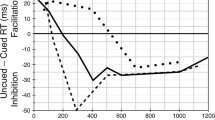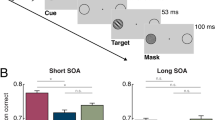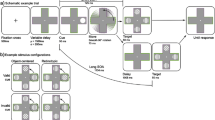Abstract
Although the inhibition of return (IOR) effect in exogenous orienting has been investigated extensively with the Posnerian cuing paradigm, there has been little evidence for the role of attentional processes in the IOR effect. The N2pc component was used as a marker of the deployment of spatial attention to isolate attentional processes in the IOR effect. Participants responded to task-relevant target displays that were preceded by cue displays in a non-predictive, exogenous cuing paradigm. A 1,000 ms of stimulus onset asynchrony (SOA) was designed to investigate the IOR effect. Behavioral results indicate that the SOA was sufficiently long to cause an IOR effect in the discrimination task. As for ERP patterns elicited by targets, the N2pc amplitudes were similar across cue types, but the N2pc latency was delayed when targets appeared at the cued location rather than at the uncued location. N2pc patterns demonstrated that the spatial attentional process is indeed an important mechanism underlying the IOR effect. The delayed N2pc for targets in the valid cue type suggested that IOR effect may reflect a delayed deployment of spatial attention to targets appearing at recently cued locations.




Similar content being viewed by others
References
Brisson B, Jolicœur P (2008) Express attentional re-engagement but delayed entry into consciousness following invalid spatial cues in visual search. PLoS One 3:e3967. doi:10.1371/journal.pone.0003967
Brisson B, Robitaille N, Jolicoeur P (2007) Stimulus intensity affects the latency but not the amplitude of the N2pc. NeuroReport 18:1627–1630
Chica AB, Lupiáñez J (2009) Effects of endogenous and exogenous attention on visual processing: an inhibition of return study. Brain Res 1278:75–85
Eimer M (1996) The N2pc component as an indicator of attentional selectivity. Electroencephalogr Clin Neurophysiol 99:225–234
Handy TC, Jha AP, Mangun GR (1999) Promoting novelty in vision: inhibition of return modulates perceptual-level processing. Psychol Sci 10:157–161
Hickey C, McDonald JJ, Theeuwes J (2006) Electrophysiologic evidence of the capture of visual attention. J Cogn Neurosci 18:604–613
Hickey C, Lollo VD, McDonald JJ (2009) Electrophysiological indices of target and distractor processing in visual search. J Cogn Neurosci 21:760–775
Hillyard SA, Vogel EK, Luck SJ (1998) Sensory gain control (amplification) as a mechanism of selective attention: electrophysiological and neuroimaging evidence. Philos Trans R Soc Lond B Biol Sci 353:1257–1270
Ivanoff J, Klein RM (2001) The presence of a nonresponding effector increases inhibition of return. Psychon Bull Rev 8:307–314
James W (1890) The principles of psychology), vol 1. Henry Holt and Co, New York
Jonides J (1981) Voluntary vs. automatic control over the mind’s eye’s movement. In: Long JB, Baddeley AD (eds) Attention and performance IX. Erlbaum, Hillsdale, pp 187–203
Kiss M, Van VJ, Eimer M (2008) The N2pc component and its links to attention shifts and spatially selective visual processing. Psychophysiology 45:240–249
Klein RM (2000) Inhibition of return. Trends Cogn Sci 4:138–147
Luck SJ (2005a) The operation of attention-millisecond by millisecond-over the first half second. In: Ogmen H, Breitmeyer BG (eds) The first half second: the microgenesis and temporal dynamics of unconscious and conscious visual processes. MIT Press, Cambridge
Luck SJ (2005b) An introduction to the event-related potential technique. MIT Press, Cambridge
Luck SJ, Hillyard SA (1994) Spatial filtering during visual search: evidence from human electrophysiology. J Exp Psychol Hum Percept Perform 20:1000–1014
Luck SJ, Girelli M, McDermott MT, Ford MA (1997) Bridging the gap between monkey neurophysiology and human perception: an ambiguity resolution theory of visual selective attention. Cogn Psychol 33:64–87
Lupiáñez J, Milán EG, Tornay FJ, Madrid E, Tudela P (1997) Does IOR occur in discrimination tasks? Yes, it does, but later. Percept Psychophys 59:1241–1254
Lupiáñez J, Milliken B, Solano C, Weaver B, Tipper SP (2001) On the strategic modulation of the time course of facilitation and inhibition of return. Q J Exp Psychol 54A:753–773
Mangun GR, Hansen JC, Hillyard SA (1987) The spatial orienting of attention: sensory facilitation or response bias. In: Johnson R, Rohrbaugh JW, Parasuraman R (eds) Current trends in event-related potential research. Elsevier, Amsterdam, pp 118–124
Mazza V, Turatto M, Caramazza A (2009) Attention selection, distractor suppression, and N2pc. Cortex 45:879–890
McDonald JJ, Ward LM, Kiehl KA (1999) An event-related brain potential study of inhibition of return. Percept Psychophys 61:141–142
McDonald JJ, Hickey C, Green JJ, Whitman JC (2009) Inhibition of return in the covert deployment of attention: evidence from human electrophysiology. J Cogn Neurosci 21:725–733
Peelen MV, Heslenfeld DJ, Theeuwes J (2004) Endogenous and exogenous attention shifts are mediated by the same large-scale neural network. Neuroimage 22:822–830
Posner MI (1980) Orienting of attention. Q J Exp Psychol 32:3–25
Posner MI, Cohen Y (1984) Components of visual orienting. In: Bouma H, Bouwhuis D (eds) Attention and performance X. Lawrence Erlbaum, London, pp 531–556
Posner MI, Cohen Y, Rafal RD (1982) Neural systems control of spatial orienting. Philos Trans R Soc Lond B Biol Sci 298:187–198
Posner MI, Rafal RD, Choate LS, Vaughan J (1985) Inhibition of return: neural basis and function. Cogn Neuropsychol 2:211–228
Prime DJ, Ward LM (2004) Inhibition of return from stimulus to response. Psychol Sci 15:272–276
Prime DJ, Ward LM (2006) Cortical expressions of inhibition of return. Brain Res 1072:161–174
Proulx MJ (2010) Size matters: large objects capture attention in visual search. PLoS One 5:e15293. doi:10.1371/journal.pone.0015293
Reuter-Lorenz PA, Jha AP, Rosenquist JN (1996) What is inhibited in inhibition of return? J Exp Psychol Hum Percept Perform 22:367–378
Ruz M, Lupiáñez J (2002) A review of attentional capture: on its automaticity and sensitivity to endogenous control. Psicológica 23:283–309
Seiss E, Kiss M, Eimer M (2009) Does focused endogenous attention prevent attentional capture in pop-out visual search. Psychophysiology 46:703–717
Spalek TM, Di Lollo V (2007) The time required for perceptual (non-motoric) processing in IOR. Psychon Bull Rev 14:327–331
Taylor TL, Klein RM (2000) Visual and motor effects in inhibition of return. J Exp Psychol Hum Percept Perform 26:1639–1656
Warner CB, Joula J, Koshino H (1990) Voluntary allocation versus automatic capture of visual attention. Percept Psychophys 48:243–251
Wascher E, Tipper SP (2004) Revealing effects of noninformative spatial cues: an EEG study of inhibition of return. Psychophysiology 41:716–728
Woodman GF, Luck SJ (1999) Electrophysiological measurement of rapid shifts of attention during visual search. Nature 400:867–869
Acknowledgments
This research was supported by the Key Discipline Fund of National 211 Project (NSKD11011), and the project sponsored by the Scientific Research Foundation for the Returned Overseas Chinese Scholars, State Education Ministry.
Author information
Authors and Affiliations
Corresponding author
Additional information
Dong Yang and Shuxia Yao contributed equally to this work.
Rights and permissions
About this article
Cite this article
Yang, D., Yao, S., Ding, C. et al. Electrophysiological evidence for inhibition of return effect in exogenous orienting. Exp Brain Res 221, 279–285 (2012). https://doi.org/10.1007/s00221-012-3170-0
Received:
Accepted:
Published:
Issue Date:
DOI: https://doi.org/10.1007/s00221-012-3170-0




